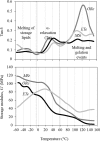Desiccation Tolerance in Chlorophyllous Fern Spores: Are Ecophysiological Features Related to Environmental Conditions?
- PMID: 31616448
- PMCID: PMC6764020
- DOI: 10.3389/fpls.2019.01130
Desiccation Tolerance in Chlorophyllous Fern Spores: Are Ecophysiological Features Related to Environmental Conditions?
Abstract
Fern spores of most species are desiccation tolerant (DT) and, in some cases, are photosynthetic at maturation, the so-called chlorophyllous spores (CS). The lifespan of CS in the dry state is very variable among species. The physiological, biochemical, and biophysical mechanisms underpinning this variability remain understudied and their interpretation from an ecophysiological approach virtually unexplored. In this study, we aimed at fulfilling this gap by assessing photochemical, hydric, and biophysical properties of CS from three temperate species with contrasting biological strategies and longevity in the dry state: Equisetum telmateia (spore maturation and release in spring, ultrashort lifespan), Osmunda regalis (spore maturation and release in summer, medium lifespan), Matteuccia struthiopteris (spore maturation and release in winter, medium-long lifespan). After subjection of CS to controlled drying treatments, results showed that the three species displayed different extents of DT. CS of E. telmateia rapidly lost viability after desiccation, while the other two withstood several dehydration-rehydration cycles without compromising viability. The extent of DT was in concordance with water availability in the sporulation season of each species. CS of O. regalis and M. struthiopteris carried out the characteristic quenching of chlorophyll fluorescence, widely displayed by other DT cryptogams during drying, and had higher tocopherol and proline contents. The turgor loss point of CS is also related to the extent of DT and to the sporulation season: lowest values were found in CS of M. struthiopteris and O. regalis. The hydrophobicity of spores in these two species was higher and probably related to the prevention of water absorption under unfavorable conditions. Molecular mobility, estimated by dynamic mechanical thermal analysis, confirmed an unstable glassy state in the spores of E. telmateia, directly related to the low DT, while the DT species entered in a stable glassy state when dried. Overall, our data revealed a DT syndrome related to the season of sporulation that was characterized by higher photoprotective potential, specific hydric properties, and lower molecular mobility in the dry state. Being unicellular haploid structures, CS represent not only a challenge for germplasm preservation (e.g., as these spores are prone to photooxidation) but also an excellent opportunity for studying mechanisms of DT in photosynthetic cells.
Keywords: desiccation tolerance; dynamic mechanical analysis; environmental conditions; glassy state; green spores; molecular mobility; tocopherol; water relations.
Copyright © 2019 López-Pozo, Ballesteros, Laza, García-Plazaola and Fernández-Marín.
Figures







Similar articles
-
Unraveling metabolic mechanisms behind chloroplast desiccation tolerance: Chlorophyllous fern spore as a new promising unicellular model.Plant Sci. 2019 Apr;281:251-260. doi: 10.1016/j.plantsci.2018.11.012. Epub 2018 Nov 22. Plant Sci. 2019. PMID: 30824058
-
Photosynthetic responses of a moss, Tortula ruralis, ssp. ruralis, and the lichens Cladonia convoluta and C. furcata to water deficit and short periods of desiccation, and their ecophysiological significance: a baseline study at present-day CO2 concentration.New Phytol. 1996 Jun;133(2):353-361. doi: 10.1111/j.1469-8137.1996.tb01902.x. New Phytol. 1996. PMID: 29681071
-
Desiccation-time limits of photosynthetic recovery in Equisetum hyemale (Equisetaceae) spores.Am J Bot. 1997 Jun;84(6):792. Am J Bot. 1997. PMID: 21708631
-
Poikilohydry and homoihydry: antithesis or spectrum of possibilities?New Phytol. 2002 Dec;156(3):327-349. doi: 10.1046/j.1469-8137.2002.00526.x. New Phytol. 2002. PMID: 33873572 Review.
-
The Orthodox Dry Seeds Are Alive: A Clear Example of Desiccation Tolerance.Plants (Basel). 2021 Dec 22;11(1):20. doi: 10.3390/plants11010020. Plants (Basel). 2021. PMID: 35009023 Free PMC article. Review.
Cited by
-
Significance of Lipid Fatty Acid Composition for Resistance to Winter Conditions in Asplenium scolopendrium.Biology (Basel). 2022 Mar 25;11(4):507. doi: 10.3390/biology11040507. Biology (Basel). 2022. PMID: 35453707 Free PMC article.
-
Desiccation tolerance in bryophytes relates to elasticity but is independent of cell wall thickness and photosynthesis.Physiol Plant. 2022 Mar;174(2):e13661. doi: 10.1111/ppl.13661. Physiol Plant. 2022. PMID: 35249226 Free PMC article.
-
Effective dispersal of fern spore and the ecological relevance of zoochory.Biol Rev Camb Philos Soc. 2025 Oct;100(5):2116-2130. doi: 10.1111/brv.70038. Epub 2025 May 29. Biol Rev Camb Philos Soc. 2025. PMID: 40439272 Free PMC article. Review.
References
-
- Abrams M. D., Kubiske M. E. (1994). Synchronous changes in tissue water parameters of mature foliage from well-watered and periodically droughted tree seedlings. J. Exp. Bot. 45, 171–177. 10.1093/jxb/45.2.171 - DOI
-
- Anderson P. D., Helms J. A. (1994). Tissue water relations of Pinus ponderosa and Arctostaphylo spatula exposed to various levels of soil moisture depletion. Can. J. For. Res. 24, 1495–1502. 10.1139/x94-193 - DOI
-
- Aranda I., Gil L., Pardos J. (1996). Seasonal water relations of three broadleaved species (Fagus sylvatica L., Quercus petraea (Mattuschka) Liebl. and Quercus pyrenaica Willd.) in a mixed stand in the centre of the Iberian Peninsula. For. Ecol. Manag. 84, 219–229. 10.1016/0378-1127(96)03729-2 - DOI
LinkOut - more resources
Full Text Sources
Miscellaneous

